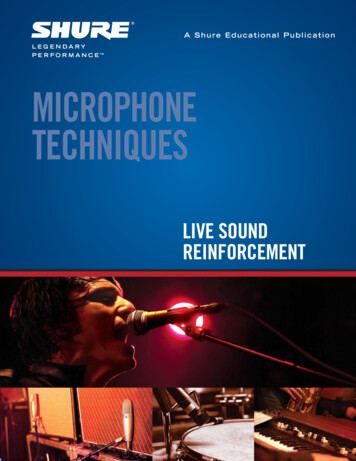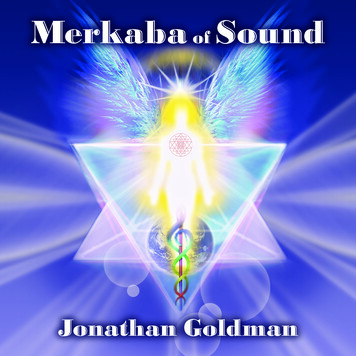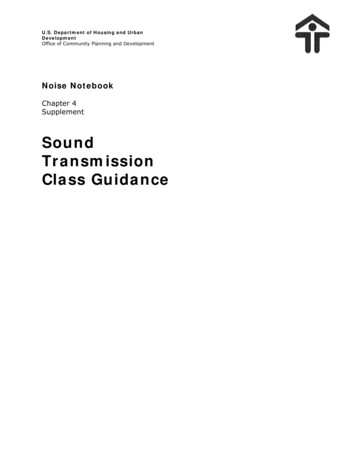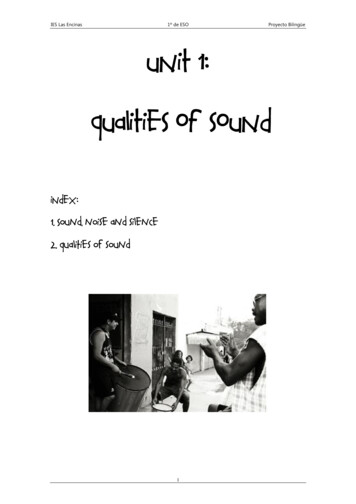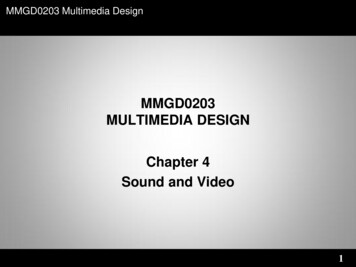
Transcription
Full-Quantitative Analysis of Cementless StemHammering Sound Changes During Total HipArthroplasty.Xu ZhuangJuntendo UniversityYasuhiro Homma ( yhomma@juntendo.ac.jp )Juntendo UniversitySeiya IshiiJuntendo UniversityItaru MorohashiJuntendo University Shizuoka HospitalHideaki IwaseJuntendo University Institute of Casualty CenterTomonori BabaJuntendo UniversityHiroki TanabeJuntendo UniversitySammy BannoJuntendo UniversityTaiji WatariJuntendo UniversityTaichi SatoTokyo Denki UniversityKazuo KanekoJuntendo UniversityMuneaki IshijimaJuntendo UniversityResearch ArticleKeywords: total hip arthroplasty, cementless stem, hammering sound, fast Fourier transform, femoral morphologyPosted Date: December 7th, 2020DOI: https://doi.org/10.21203/rs.3.rs-115355/v1License: This work is licensed under a Creative Commons Attribution 4.0 International License. Read FullLicensePage 1/17
AbstractFull-quantitative characterization has not been performed to analyze changes in the hammering sound incementless hip arthroplasty. We analyzed the frequency spectrum of the hammering sound during stem insertionfor 20 cases of uncomplicated cementless total hip arthroplasty for osteoarthritis using a proximal-coated stem.The absolute sound pressure (Pa) and normalized sound pressure of each frequency bands in early and late stageof femoral stem insertion were determined by the Fast Fourier Transform analysis. The absolute sound pressures(Pa) of a majority of frequency bands was significantly higher in the late-stage stem insertion than in the early stageThe 1.0–1.5-kHz frequency band showed a significant change in normalized sound pressure in all cases betweenthe early and late stages of stem insertion (p 0.000). The femoral morphology and canal fill ratio were correlatedwith late stage normalized sound pressure in specific frequency bands. In the 5.0–5.5 kHz band, the Dorr A femoralmorphology was significantly higher normalized sound pressure than those in the Dorr B (p 0.004). This studyrevealed the hammering sound frequency with full-quantitative value altered during cementless stem insertion.Frequency bands of 1.0–1.5 kHz, 5.0–5.5 kHz were the key bands for predicting stem fixation.IntroductionTotal hip arthroplasty (THA) is one of the most successful surgical treatments and is reported to greatly reduce painand restore hip function and the quality of life of patients with end-stage hip disease in both short-term and longterm follow-up 1,2. As the population ages, the demand for primary THA and revision THA has increased rapidly inrecent years 3.Although the use of cementless fixation in THA has increased globally, complications, such as intraoperativefemoral fracture and implant subsidence, can occur after inappropriate and inadequate stem implantation 4,5. Thesecomplications can compromise the surgical effect and increase the risks of dislocation, aseptic implant looseningand revision surgery 6,7.Several new technologies, such as preoperative three-dimensional (3D) templating and intraoperative navigation,have been used to avoid inadequate stem selection and achieve better stem positioning. Schiffner et al. reportedthat the accuracy of predicting the right stem size improved from 45.7% to 58.6% using 3D templating comparedwith 2D surgical planning 8. Weber et al. found similar accuracy in biomechanical hip reconstruction of the leglength and global and femoral offset in THA between intraoperative navigation and fluoroscopy 9.Addition to those new imaging tools, because experienced surgeons use the auditory sensation of a hammeringsound during stem insertion to determine proper/improper stem sitting, researchers have attempted to analyze thehammering sound. Morohashi et al. reported on acoustic frequency patterns and found that a natural hammeringfrequency of approximately 7 kHz was the most prominent frequency in patients without complication 10. Connell etal. reported that a frequency around 1 kHz could better predict an adequately sized stem using spectrographs 11.However, no full-quantitative characterization has been performed for the changes in hammering sound frequencyduring cementless stem insertion, and the relationship between the hammering sound frequency and the femoralmorphology and canal fill ratio is unknown. Therefore, we asked two questions. 1) Is the hammering soundfrequency with full-quantitative value altered during cementless stem insertion? 2) Is the hammering soundfrequency correlated with the femoral morphology and canal fill ratio of the stem? This study was conducted toPage 2/17
objectively analyze the changes in hammering sound frequency during cementless stem insertion and therelationship between the hammering sound frequency and femoral morphology and canal fill ratio of the stem.MethodsPreliminary experimentsThe natural frequencies ( 10 kHz) of surgical instruments used in THA surgery, including a hip prosthesis (AccoladeII, Stryker, Tokyo, Japan), surgical hammer (stainless hammer 01-412-01 Large, Mizuho, Tokyo, Japan), and modularhandle and stem impactor (1020-2900, 1020-1870, Stryker, Tokyo, Japan), were analyzed in an anechoic room usinga previously described method 10.PatientsAll procedures performed in this study involving human participants were in accordance with the ethical standardsof the institutional and/or national research committee and the 1964 Helsinki declaration and its later amendmentsor comparable ethical standards. The study protocol was approved by the Ethics Committee of Juntendo UniversityHospital, Tokyo, Japan. Informed consent was obtained in a manner approved by the Ethics Committee from allindividual participants included in this study. From November 2018 to October 2020, 62 patients (65 hips)undergone Primary THA who agreed to participate to this study were initially included (Fig. 1). Exclusion criteriawere (i) patients who underwent THA for osteonecrosis, femoral neck fracture, or rheumatoid arthritis (ii) the surgeryused a prosthesis other than the Accolade II stem, (iii) the surgery was performed by a junior surgeon, and (iv)patients had stem subsidence ( 2 mm) at 1 month post-operation. After reviewing the inclusion and exclusioncriteria, 17 women and 3 men were included, with an average age of 66.4 8.23 years and an average body massindex of 23.76 2.77 kg/m2. One patients had simultaneous bilateral THA. To investigate the sound frequencychanges among femoral morphologies, these patients were divided into the Dorr A and Dorr B groups (no patienthad a Dorr C-type femur) based on Dorr classification 12.Surgical procedureThe surgeries were performed by four experienced orthopedic surgeons via the direct anterior approach with acementless proximal hydroxyapatite-coated stem (Accolade II, Stryker, Tokyo, Japan) using the distal part of theSmith-Petersen approach with the patient in the supine position on a surgical traction table as previously described13.The following is the brief description of this surgical procedure 13. The fascia of the tensor fascia lata musclewas incised at approximately 2 cm lateral to the skin incision to prevent lateral femoral cutaneous nerve injury. Theintermuscular space between the tensor fascia lata and sartorius muscles was then bluntly entered. The anteriorarticular capsule was exposed and incised. Intraoperative X-ray photography was used to confirm that the broachwas appropriately aligned, and the porous part of the broach contacted the cortical bone. The stem size wasdetermined using the same size of the last trial insertion of the broach. All patients underwent standardizedpostoperative rehabilitation with full weight bearing 1-day post-surgery.Sound data collection during the THAA highly sensitive sound level meter (LA-7500, Onosokki, Kanagawa, Japan) was used to record the hammeringsound of the stem insertion. In all cases, the sound level meter was set on a tripod mount at 1 m high and 2 m awayfrom the surgical table in the same operating room (Fig. 2). Recordings were made in the range of 40–110 dB usingPage 3/17
Z frequency weighting (flat-weighted filter) and fast time weighting at a sampling rate of 64 kHz and a 16-bitsampling depth.Sound data analysisOscope ver 2.1, (Onosokki, Kanagawa, Japan) was used for the sound analysis. Recorded sound data wereanalyzed using a rectangular weighted window and 50% overlap at a maximum range of 12.5 kHz via fast fouriertransform (FFT) analysis (Fig. 3). The first three and last one hammering sounds during the stem insertion wereexcluded from the analysis to avoid potential hammering inconsistencies, The fourth to sixth hammering soundswere defined as early-stage insertion hammering sounds. The second to fourth hammering sounds from the endwere defined as late-stage insertion hammering sounds. If noises were mixed in with these hammering sounds, oran improper hammering was detected on the spectrogram, those hammering sound would be switched to theprevious or next one.The following analysis compared the early- and late-stage insertion hammering sounds. The overall spectrumfrequency of the recorded sound was divided into 25 frequency bands in the range of 0.5 kHz from 0–12.5 kHz.Because frequency bands below 0.5 kHz were mixed with noises ranging from 0.08–0.26 kHz, such as voicedspeech from a typical adult, 0–0.5 kHz was thought to inaccurately reflect sound changes during the stem insertion.Moreover, previous studies detected no changes below 0.5 kHz 10,11,14. Therefore, the 0–0.5 kHz frequency bandwas excluded from the comparison. Sound changes between the early and late stages were compared first by usingthe absolute sound pressure (Pa) and then by using the normalized sound pressure in each frequency band.Because the average overall absolute sound pressure (Pa) differed between the early and late stages, the analysisusing the normalized sound pressure was used. Normalized sound pressure was calculated as the ratio of theabsolute sound pressure (Pa) of each frequency band to the average overall frequency spectrum (0.5–12.5kHz).Next, correlations were determined between the femoral morphology, canal fill ratio and absolute sound pressure(Pa), followed by normalized sound pressure in the late stage. Finally, sound changes between Dorr A and B weredetermined for the late stage.Assessment ofthefemoral morphology and canal fill ratio of the stem.Radiographs of the femoral morphology and canal fill ratio were assessed using the final preoperative andimmediate postoperative Anterior Posterior hip radiographs. Preoperative radiographs were used to analyze fivemorphologic parameters as follows.(i) Canal-calcar ratio (CCR): ratio of the intracortical diameter of the femoral canal isthmus at 10 cm below thelesser trochanter to the intracortical diameter of the proximal femur at the medial tip of the lesser trochanter 15.(ii) Canal-flare index (CFI): ratio of the intracortical diameter of the proximal femoral isthmus at 2 cm above thelesser trochanter to the intracortical diameter of the femoral canal isthmus at 10 cm below the lesser trochanter 16.(iii) Morphologic cortical index (MCI): ratio of the extracortical diameter of the femur at the medial tip of the lessertrochanter to the intracortical femoral diameter at 7 cm below the lesser trochanter 15,17.(iv) Canal-bone ratio (CBR): ratio of the intracortical and extracortical diameters of the femoral canal isthmus at 10cm below the lesser trochanter 18.Page 4/17
Postoperative radiography was used to assess the canal fill ratio (CFR) of the stem, defined as the stem widthdivided by the canal width at four points at the lesser trochanter, 2 cm above, 2 cm below, and 7 cm below the lessertrochanter. The proximal-distal matching ratio of the CFR at 2 cm above and 7 cm below the lesser trochanter wasalso considered 19.A single observer (S.I.) who was not involved in the sound analysis analyzed the measurements. Radiographs wereassessed using the ruler function of the Picture Archiving and Communication System at our institution (FujifilmSynapse 3.2.1 SR-356; Fujifilm Corp, Tokyo, Japan).Statistical analysisStatistical analysis was performed using SPSS software, ver 26.0 (IBM, Armonk, NY, USA). Patient demographicsare expressed as the mean standard deviation. Two-tailed paired t-tests and Wilcoxon signed-rank tests were usedto compare paired data. Spearman rank correlation was used to evaluate relationships between variables.Differences and correlations were considered statistically significant if p 0.05.ResultsNatural frequencies of the surgical instrumentsFig. 4 shows the natural frequencies of the surgical instruments. Four frequencies dominated in the Accolade IIfemoral stem. Both 2.7 and 4.1 kHz were observed in sizes 3 and 4. The other two frequencies (6.4 and 9.2 kHz) ofstem size 4 were slightly lower than those of size 3 (6.6 and 9.7 kHz). The dominant surgical hammer frequencieswere 2.1, 4.4, and 8.2 kHz. Four frequencies (1.1, 2.9, 5.6 and 9.0 kHz) dominated with the stem impactor and threefrequencies (2.0, 5.2 and 7.7 kHz) dominated with the modular handle. When hitting the modular handle with thestem impactor attached, all three dominant frequencies of modular handle (2.0, 5.2 and 7.7 kHz) and only 9.0 kHzfrom the stem impactor occurred. An additional dominant frequency of 3 kHz was noted when the impactor was hit.Full-quantitative analysis of the sound changes between the early and late stagesThe absolute sound pressures (Pa) of a majority of frequency bands except 5.0–6.0, 8.5–10.0 and 12.0–12.5 kHzwas significantly higher in the late-stage stem insertion than in the early stage (Fig. 5A).The normalized sound pressure of 0.5–1.0 (p 0.012), 1.0–1.5 kHz (p 0.0004) in the late stage were significantlyhigher than that in the early stage The normalized sound pressures of 5.0–5.5 (p 0.022), 5.5–6.0 kHz (p 0.00004)and 9.0–9.5 kHz (p 0.01) were lower than those in the early stage (Fig. 5B).Correlations between femoral morphology, CFR and normalized sound pressureThe CCR and MCI were significantly correlated with the normalized sound pressures of 5.0–5.5 kHz (CCR: r -0.567,p 0.009; MCI: r 0.490, p 0.028) in the late-stage stem insertion (Table.1). The CBR was significantly correlated withthe normalized sound pressures of 3.5–4.0 kHz (r 0.484, p 0.031), 7.0–7.5 kHz (r 0.552, p 0.012). The CFI wasnot significantly correlated with normalized sound pressure in any frequency spectrum (Table.1).The CFR at 2 cmabove the lesser trochanter was significantly positively correlated with the normalized sound pressures of 1.5–2.0kHz (r 0.463, p 0.040) and 3.0–3.5 kHz (r 0.530, p 0.016). The CFR at the lesser trochanter was significantlypositively correlated with the normalized sound pressures of 0.5–1.0 kHz (r 0.472, p 0.036), 3.0–3.5 kHz (r 0.460,p 0.041) and negatively correlated with the normalized sound pressure of 5.0–5.5 kHz (r 0.493, p 0.027). ThePage 5/17
CFR at 7 cm below the lesser trochanter was negatively correlated with the normalized sound pressure of 4.0–4.5kHz (r 0.450, p 0.047) and 8.0–8.5 kHz (r –0.448, p 0.048).Comparisons between Dorr A-type and Dorr B-type femursPatients characteristic in each group is shown in Table.2. In the Dorr A group, the normalized sound pressure of 1.01.5 kHz in the late stage was significantly higher than that in the early stage (p 0.022), (Fig. 6). The normalizedsound pressure of 5.5-6.0 and 6.0-6.5 kHz in the late stage were significantly lower than those in the early stage(p 0.008, p 0.016, Fig. 6A). In the Dorr B group, 0.5-1.0 and 1.0-1.5 kHz in the late stage were significantly higherthan those in the early stage (p 0.005, p 0.019). And the normalized sound pressure of 2.0-2.5, 5.0-5.5, 5.5-6.0 and9.0-9.5 were significantly lower than those in the those in the early stage (p 0.045, p 0.004, p 0.002, p 0.033, Fig.6B). Comparing the normalized sound pressures in the late stage between Dorr A and B, 5.0–5.5 kHz (p 0.006) inthe Dorr A group were significantly higher than those in the Dorr B group (Fig. 6C).DiscussionAlthough cementless THA can relieve pain and restore mobility, the incidence of specific complications, such asintraoperative fractures or postoperative subsidence, remain problematic. Previous studies have shown the acousticevaluations based on the hammering sounds during THA can predict stem stability 10,11,20. However, the soundchanges reported in these studies differed and could not easily be distinguished. Moreover, no full-quantitativeanalysis of the sound frequency has been performed thus far. In the present study, we performed a full-quantitativeanalysis using normalized sound pressure to quantify the sound quality and found that the characteristic of thesound frequency changed during cementless stem insertion and that the sound frequency was correlated with thefemoral morphology and CFR.We believe that using normalized sound pressure to assess the hammering sound frequency is more reliable andobjective. Assessments based on absolute sound pressure make the results unclear because they are affected bythe different hammering forces. Although the surgeons who participated in our study were asked to deliver aconsistent hammering force during the stem insertion, standardizing the hammering force among the surgeons wasdifficult. The absolute sound pressure was higher in the late stage than in the early stage, likely because thesurgeons are more cautious and more likely to deliver less force at the beginning of a stem insertion. Previousstudies suggested that presence of the prominent frequency accentuation of the absolute sound pressure couldeffectively predict stability of the broach or stem 10,11. However, some of our FFT analysis results showed that theprominent frequency differed among patients despite the surgery having been performed flawlessly withoutcomplications (Fig. 3). In some cases, the prominent frequency occurred in the early-stage rather than late-stagestem insertion. Regarding the femoral morphology and CFR, McConnell et al. reported a positive correlation betweensound change in the recorded frequency and femoral length, but not with the cortical thickness 11. Our study yieldedthat hammering sound in the late stage were significantly correlated with the femoral morphology/CFR with theassessment of normalized sound pressure.Our data suggest that two principals are important for understanding the sound analysis and further study of thesound frequency. First, the hammering sound frequency depends on femoral morphology. Second, the hammeringfrequency differs in whether the cementless stem reaches the aimed fixation contact area of the femur. Ideally, ahigh CCR indicates that the intracortical diameter of the distal femoral canal isthmus will be relatively large, and thestem is more likely to become fixed at the proximal femur. Our results showed that sound pressures of 5.0–5.5 kHzPage 6/17
in the late stage were significantly lower in the Dorr B group than in the Dorr A group (those with “champagne-flute”morphology of the proximal femur). In addition, the normalized sound pressure of 5.0–5.5 kHz between the earlyand late stages was decreased in the Dorr B group (Fig. 6B) but not in the Dorr A group (Fig. 6A). We speculate thatthe sound pressure changes of 1.0–1.5 kHz could be used to predict whether the stem is well-fixed and that 5.0–5.5kHz could distinguish whether the stem is fixed proximally or distally.Regarding 1.0–1.5kHz, our data showed that the changes from early to late stem insertion at 1–1.5 kHz ofnormalized sound pressure were significantly higher in both Dorr A and B patients (Fig. 6A, 6B). This finding issimilar to that of McConnell et al., who analyzed frequency changes during the femoral broach. McConnell et al.found an additional frequency band around 1 kHz in the final femoral broach, which they thought indicated that thebroach was well fitted 11. Whitwell et al. theorized that the 1-kHz frequency band was the sound wave created by thefemoral canal, as a well-fitted broach yields better bone contact, leading to more efficient energy transfer and hencea greater bone vibration 21. Although we agree with the theory of McConnell et al., we postulate that the stemimpactor could also generate the sound change around 1 kHz. Although measuring the natural bone-musclecomposite frequencies was difficult, our preliminary experimental results confirmed that 1 kHz was a naturalfrequency of the impactor. When the stem is fixed with the bone, both the bone and the stem impactor yield greatervibrations owing to increased reaction forces, leading to the changes around 1 kHz.At 5.0–5.5 kHz, we believe that the femur-stem system generates the sound change when the stem is fixed at theproximal part. When the proximal-coated stem is fixed proximally at the femoral canal, the stem is sufficiently filledproximally, whereas if the proximally-coated stem is fixed distally, the stem moves like a windshield wiper, known asproximal-distal-mismatch 1922. The bone cannot be well integrated with the stem and thus cannot vibrate as asingle system. Jaecques et al. reported a similar result after using an artificial bone and a custom made stem tosimulate the vibration system change between a “loosely inserted” initial stage to a well fixed final stage, butwithout using a stem impactor. The sound value around 4 kHz was gradually increased and the sound value around8.5 kHz was gradually decreased as the stem became more fixed to the bone23.This study had several limitations. First, the sample size was small. However, despite the small number of patients,the characteristic objective data showed significant differences. Second, the hammering style and force were notpractically standardized; thus, different vibration modes may have affected the accuracy of the results. Although weused normalized sound pressure to quantify sound changes, this method still required a baseline of the averageoverall frequency spectrum. Thus, the frequency range should be chosen carefully. Third, noises in the operatingenvironment, such as the electrocardiograph monitoring alarm, could affect the recorded sound quality. Althoughthe hammering sounds with obvious background noise were excluded, they will inevitably have influenced theresults. However, the possible sound effects from the noises in the operating environment were minimal in ouranalysis compared with the hammering sounds. Moreover, we aimed to determine the possibility of clinically usingthe sound analysis in the most practical sitting environment with general noise from the operating field.ConclusionThis study revealed the full-quantitative sound changes during proximal-coated cementless stem insertion usingnormalized sound pressure, which was useful for quantifying the sound analysis with no effect of hammering force.The sound changes were correlated with the femoral morphology and CFR. Frequency bands of 1.0–1.5 kHz, 5.0–5.5 kHz were the key bands for predicting stem fixation. Further study is needed to determine the relationshipbetween complications and characteristic sound frequencies in the key bands.Page 7/17
DeclarationsData availabilityThe datasets used and/or analyzed during the current study are available from the corresponding author onreasonable request.AcknowledgmentThis work was supported by JSPS KAKENHI Grant-in-Aid for Early-Career Scientists JP19K18542.We thank Traci Raley, MS, ELS, from Edanz Group (https://en-author-services.edanzgroup.com/) for languageediting a draft of this manuscript.Author contributionsYH conceived and designed research. SI, TW, SB, HT and TB obtained the data. YH and XZ analyzed data. XZ wrotethe initial manuscript. YH revised the manuscript. IM, HI, KK, and IM interpretated the data. All authors read andapproved the manuscript.Additional informationThe authors declare no competing interests.References1. Homma, Y. et al. In total hip arthroplasty via the direct anterior approach, a dual-mobility cup preventsdislocation as effectively in hip fracture as in osteoarthritis. Int Orthop 41, 491-497, doi:10.1007/s00264-0163332-y (2017).2. Tyrpenou, E. et al. A large-scale fifteen year minimum survivorship of a cementless triple tapered femoral stem.The Journal of Arthroplasty, doi:10.1016/j.arth.2020.03.028 (2020).3. Kurtz, S., Ong, K., Lau, E., Mowat, F. & Halpern, M. Projections of primary and revision hip and knee arthroplastyin the United States from 2005 to 2030. J Bone Joint Surg Am 89, 780-785, doi:10.2106/JBJS.F.00222 (2007).4. Wacha, H., Domsel, G. & Herrmann, E. Long-term follow-up of 1217 consecutive short-stem total hiparthroplasty (THA): a retrospective single-center experience. Eur J Trauma Emerg Surg 44, 457-469,doi:10.1007/s00068-017-0895-2 (2018).5. Rivera, F., Leonardi, F., Evangelista, A. & Pierannunzii, L. Risk of stem undersizing with direct anterior approachfor total hip arthroplasty. Hip Int 26, 249-253, doi:10.5301/hipint.5000337 (2016).6. Moskal, J. T., Capps, S. G. & Scanelli, J. A. Still no single gold standard for using cementless femoral stemsroutinely in total hip arthroplasty. Arthroplast Today 2, 211-218, doi:10.1016/j.artd.2016.02.001 (2016).7. Khatod, M. et al. Revision total hip arthoplasty: factors associated with re-revision surgery. J Bone Joint SurgAm 97, 359-366, doi:10.2106/jbjs.N.00073 (2015).8. Schiffner, E. et al. Is computerised 3D templating more accurate than 2D templating to predict size ofcomponents in primary total hip arthroplasty? Hip Int 29, 270-275, doi:10.1177/1120700018776311 (2019).9. Weber, M. et al. Fluoroscopy and imageless navigation enable an equivalent reconstruction of leg length andglobal and femoral offset in THA. Clin Orthop Relat Res 472, 3150-3158, doi:10.1007/s11999-014-3740-5Page 8/17
(2014).10. Morohashi, I. et al. Acoustic pattern evaluation during cementless hip arthroplasty surgery may be a newmethod for predicting complications. Sicot j 3, 13, doi:10.1051/sicotj/2016049 (2017).11. McConnell, J. S., Saunders, P. R. J. & Young, S. K. The clinical relevance of sound changes produced duringcementless hip arthroplasty: a correctly sized femoral broach creates a distinctive pattern of audio frequenciesdirectly related to bone geometry. Bone Joint J 100-b, 1559-1564, doi:10.1302/0301-620x.100b12.Bjj-20180368.R2 (2018).12. Dorr, L. D. et al. Structural and cellular assessment of bone quality of proximal femur. Bone 14, 231-242,doi:10.1016/8756-3282(93)90146-2 (1993).13. Banno, S. et al. Use of traction table did not increase complications in total hip arthroplasty through directanterior approach performed by novice surgeon. J Orthop Surg (Hong Kong) 28, 2309499020923093,doi:10.1177/2309499020923093 (2020).14. Qi, G., Mouchon, W. P. & Tan, T. E. How much can a vibrational diagnostic tool reveal in total hip arthroplastyloosening? Clin Biomech (Bristol, Avon) 18, 444-458, doi:10.1016/s0268-0033(03)00051-2 (2003).15. Dorr, L. D. Total hip replacement using APR system. Techniques in Orthopaedics 1, 22-34 (1986).16. Noble, P. C. et al. The anatomic basis of femoral component design. Clinical Orthopaedics and RelatedResearch, 148-165 (1988).17. Spotorno, L. & Romagnoli, S. Indications for the CLS stem. The CLS uncemented total hip replacement system.Berne, Switzerland: Protek, 4 (1991).18. Engh, C. A., Bobyn, J. D. & Glassman, A. H. Porous-coated hip replacement. The factors governing boneingrowth, stress shielding, and clinical results. Journal of Bone and Joint Surgery - Series B 69, 45-55 (1987).19. Ishii, S. et al. Does the Canal Fill Ratio and Femoral Morphology of Asian Females Influence Early RadiographicOutcomes of Total Hip Arthroplasty With an Uncemented Proximally Coated, Tapered-Wedge Stem? JArthroplasty 31, 1524-1528, doi:10.1016/j.arth.2016.01.016 (2016).20. Unger, A. C., Cabrera-Palacios, H., Schulz, A. P., Jürgens, C. & Paech, A. Acoustic monitoring (RFM) of total hiparthroplasty - Results of a cadaver study. Eur J Med Res 14, 264-271, doi:10.1186/2047-783x-14-6-264 (2009).21. Whitwell, G., Brockett, C. L., Young, S., Stone, M. & Stewart, T. D. Spectral analysis of the sound produced duringfemoral broaching and implant insertion in uncemented total hip arthroplasty. Proc Inst Mech Eng H 227, 175180, doi:10.1177/0954411912462813 (2013).22. Cooper, H. J., Jacob, A. P. & Rodriguez, J. A. Distal fixation of proximally coated tapered stems may predisposeto a failure of osteointegration. J Arthroplasty 26, 78-83, doi:10.1016/j.arth.2011.04.003 (2011).23. Jaecques, S., Pastrav, C., Zahariuc, A. & Van der Perre, G. in Proceedings of ISMA2004 International Conferenceon Noise and Vibration Engineering. 20-22 (KU Leuven Belgium).TablesTab.1 Correlations between femoral morphology and canal fill ratio with the normalized sound pressure of eachfrequency band in the late stage of stem insertionPage 9/17
Femoral morphology indexCanal fill MorphologiccorticalindexCanalboneratio2 cmabovelessertrochanter2 cmbelow7 0-0.4050.1290.0960.125-0.030-0.1900.25
The natural frequencies ( 10 kHz) of surgical instruments used in THA surgery, including a hip prosthesis (Accolade II, Stryker, Tokyo, Japan), surgical hammer (stainless hammer 01-412-01 Large, Mizuho, Tokyo, Japan), and modular handle and stem impactor (1020-2900, 1020-1870, Stryker, Tokyo, Japan), were analyzed in an anechoic room using

